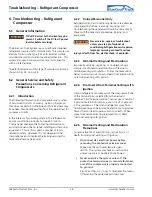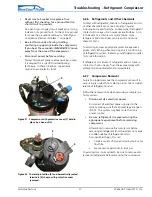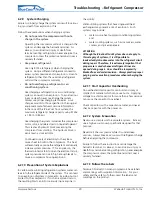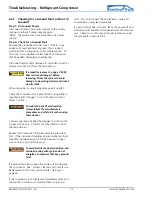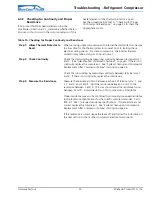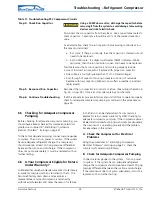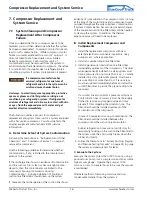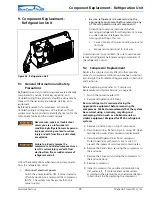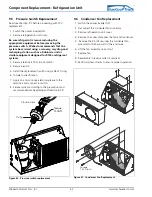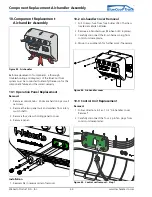
Troubleshooting – Refrigerant Compressor
www.webasto.us
29
Webasto Product N.A., Inc.
™
6.2.9
System Charging
Failure to properly charge the system can result in serious
injury or death from explosion or fire.
Follow these precautions when charging a system.
•
Do not operate the compressor without a
charge in the system.
Operating the compressor without a charge in the
system can damage the hermetic terminal. As
always, to avoid serious injury or death from
terminal venting with ignition, never energize the
compressor unless the protective terminal cover is
securely fastened.
•
Use proper refrigerant.
Use only R134a refrigerant when charging the
system. Using a different refrigerant can lead to
excess system pressure and an explosion. Use of a
refrigerant other than the serial label refrigerant
will void the compressor warranty.
•
Do not overcharge a refrigerant or air
conditioning system.
Overcharging a refrigeration or air conditioning
system can result in an explosion. To avoid serious
injury or death, never overcharge the system.
Always use proper charging techniques. Limit
charge amounts to those specified in the original
equipment manufacturer’s service information.
In the case of the BlueCool Truck system, the
maximum refrigerant charge capacity using R134a
is 1.85 lb (0.84 kg).
Overcharging the system immerses the compressor
motor, rotor, and related parts in liquid refrigerant.
This creates a hydraulic block preventing the
compressor from starting. The hydraulic block is
also known as locked rotor.
Continued supply of electricity to the system
causes heat to build in the compressor. This heat
will eventually vaporize the refrigerant and rapidly
increase system pressure. If, for any reason, the
thermal protector fails to open the electrical circuit,
system pressure can rise to high enough levels to
cause a compressor housing explosion.
6.2.10 Prevention of System Explosions
In certain water-utilizing refrigeration systems, water can
leak into the refrigerant side of the system. This can lead
to an explosion of system components, including but not
limited to, the compressor. If such an explosion occurs,
the resulting blast can kill or seriously injure anyone in
the vicinity.
Water-utilizing systems that have single-wall heat
exchangers may present a risk of explosion. Such
systems may include:
•
water source heat pump/air conditioning systems,
and
•
water cooling systems, such as ice makers, water
coolers, and juice dispensers.
ATTENTION
Although the BlueCool Truck System does not apply to
this category of systems, it is still possible to
inadvertently introduce water into the refrigerant circuit
during repair. Therefore, it is extremely important that
proper care is used whenever refrigerant lines are
opened during repair. Lines should be temporarily
blocked to avoid water incursion. Always practice proper
purging and evacuation procedures when recharging the
system.
6.2.11 Start Capacitor Overheating
An overheated start capacitor can burst and spray or
splatter hot material which can cause burns. Applying
voltage to a start capacitor for more than a few seconds
can cause the capacitor to overheat.
Check capacitors with a capacitance meter, and never
check a capacitor with the power on.
6.2.12 System Evacuation
Never use a compressor to evacuate a system. Instead,
use a high vacuum pump specifically designed for that
purpose.
Never start the compressor while it is under deep
vacuum. Always break a vacuum with refrigerant charge
before energizing the compressor.
Failure to follow these instructions can damage the
hermetic terminal. As always, to avoid serious injury or
death from terminal venting with ignition, never energize
the compressor unless the protective terminal cover is
securely fastened.
6.2.13 Follow the Labels
Tecumseh Products Company compressors have labels
and markings with important information. For your
safety and the safety of others, read the labels and
markings on the product.












